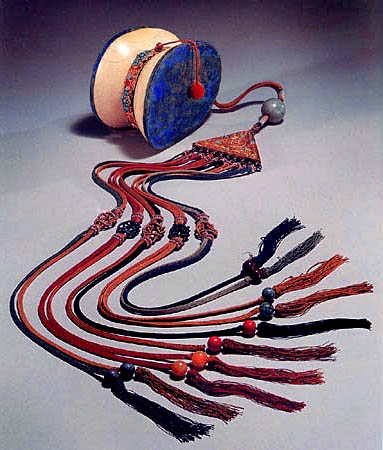
Ivory damaru
with a braided chöphen
This ivory damaru has a chöphen in a different style to those usually created by Aro practitioners. The chöphen—or reality flag—is both functional and symbolic. Functionally it adds weight to the drum, making it sit in the hand more fully and making the drum easier to play. Symbolically the chöphen represents a cloud with rays of light emanating from it.
Ngakma Nor’dzin comments:
In a wet country like Wales we may not think of a cloud as an auspicious symbol as it portends rain, but in an arid country like Tibet a cloud would be a welcome sight. A cloud shields us from the hot sun of samsara; nourishment comes from a cloud; and light pours out from behind it.
Chöphen often display five sections and five colours representing the elements as the rainbow colours of the light rays. Here the braids are in red and blue in five sections. The beads on the braids add weight to the chöphen as well as being ornamental.
Ngak’chang Rinpoche remarks:
Practitioners can use their imagination in creating a chöphen to make something beautiful and meaningful. I have seen a chöphen with an iron filigree cloud, like a cage in swirling shapes of iron which contained a brocade cloud, with streamers coming from it. Chöphen can be made in so many different styles. The different colours and styles are an important expression of the practitioner's connection with symbolic practice. We put effort into making our practice equipment as beautiful and meaningful as possible. Meditation practice and study are essential, but human beings are not always capable of devoting all their time to that, so there is the tradition of creating wonderful external objects as a support for practice. We can channel our need for artistic expression into our practice equipment. This is time associated with practice – although it is not the same as silent sitting, it has a devotional quality, and is a way to use time that supports us as human beings connected with practice.
Here the skin of the drum has been dyed blue. Green is the more common colour for a damaru skin, but both blue and green are used.
